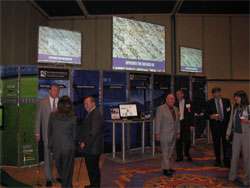Clean Energy and Conservation Collide in California Coastal Waters
March 19, 2024 —
Nadia Lopez & Josh Saul - BloombergTwo of President Joe Biden’s biggest priorities — conservation and the switch to clean energy — are colliding in the ocean off California’s quiet Central Coast.
Located halfway between San Francisco and Los Angeles, Morro Bay boasts a rich ecosystem of fish, otters and migrating whales that the Indigenous Chumash people want to protect with a
new marine sanctuary. But 20 miles (32 kilometers) out, developers plan some of the West Coast’s
first offshore wind farms, where 1,100-foot-tall turbines (335 meters) tethered to the seabed will help California cut its carbon emissions.
One US government agency appears poised to approve the sanctuary. Another
already leased 376 square miles of ocean for wind development, just outside the sanctuary’s boundaries. Now, a fight is brewing over whether the scenic bay itself should be left out of the sanctuary, to give undersea power cables from the wind farms a place to come onshore.
Reprinted courtesy of
Nadia Lopez, Bloomberg and
Josh Saul, Bloomberg Read the court decisionRead the full story...Reprinted courtesy of
How the Pandemic Pushed the Construction Industry Five Years Into the Future
September 06, 2021 —
Alexandra McManus & Hussein Cholkamy - Construction ExecutiveOn any given day, there are a multitude of variables playing out on construction jobsites, from maintaining daily logs to track hundreds of workers to creating daily schedules to keep projects on track. What made an industry that’s arguably about 20 years in the past get a dramatic technology boost five years into the future? A global pandemic that nobody saw coming.
When COVID-19 made its first appearance on construction sites in early 2020, the domino effect of project shutdowns and labor shortages created uncertainty along with budget and timeline nightmares. The pandemic shook up the industry, with many projects coming to a screeching halt. As general contractors scrambled to keep their projects moving and workers safe, technology proved to be the solution.
With jobsites shutting down, coupled with a nationwide labor shortage, real-time visibility over workforce variables, such as who was on-site, where they were and who they interacted with was more important than ever. Safe proximity tracking, virtual density and access control technologies helped construction companies gain more control, visibility and the ability to deal with the ever-changing regulations due to the global pandemic. More importantly, it helped keep their valuable workforce safe.
Reprinted courtesy of
Alexandra McManus & Hussein Cholkamy, Construction Executive, a publication of Associated Builders and Contractors. All rights reserved.
Mr. Cholkamy may be contacted at hussein@eyrus.com
Ms. McManus may be contacted at alex@eyrus.com
Read the court decisionRead the full story...Reprinted courtesy of
Liebherr Claims Crane Not Cause of Brazil Stadium Construction Accident
February 14, 2014 —
Beverley BevenFlorez-CDJ STAFFCrane manufacturer Liebherr said in a statement that “its crane was not the cause” of the November 2013 construction incident that killed two workers, according to KHL. Liebherr claimed that “its investigations show that the crane had no technical defects and that the ground was not sufficiently stable for crane travel with a suspended load on the day of the accident.”
Liebherr “assumes that all the reports currently being prepared about the accident will not reach any different conclusions,” reported KHL.
Read the court decisionRead the full story...Reprinted courtesy of
2011 West Coast Casualty Construction Defect Seminar – Recap
June 01, 2011 —
CDJ STAFF �  | �
�| Event exhibitors and sponsors contribute to an informative and engaging environment | �
�This year’s meeting was the best yet for the industry-leading construction defect and claims event.
�This year’s seminar concluded on May 13, 2011 with the Construction Defect Community Charitable Foundation Golf Tournament, held at Strawberry Farms Golf Course.
�The Disneyland Hotel in Anaheim, California was the place where more than 1,500 attendees convened for two days of professional development activities and seminars that included CLE workshops and panel discussions of special interest to legal and insurance professionals concerned with construction defect and claims litigation. Key events included “Challenges for Experts in Construction Defect Claims and Litigation,” “Keeping Up with Construction Defect Coverage,” and “Tips for Avoiding the ‘Perfect Storm’ in Handling of Wrap Claims.”
� �  | �
�| Supporting the golf tournament at the 15th hole | �
�This year’s Ollie award was given to George D. Calkins II, Esq. The West Coast Casualty Jerrold S. Oliver Award of Excellence was named in honor of the late Judge Jerrold S. Oliver, and recognizes an individual who is outstanding or has contributed to the betterment of the construction community.
�In addition to being the most comprehensive professional development seminar in the area of construction defects, this year’s seminar was equally valuable as a networking opportunity for members of the industry. People participated in professional development events during the day and then continued networking in the evening at numerous social events. The Lawn Party as well as the legendary Wood, Smith, Henning & Berman events were very well attended. Additional valuable networking events were hosted by a number of industry professionals at the House of Blues, and Tortilla Joe’s.
�As of this writing the 2011, West Coast Casualty's Construction Defect Seminar has applied for or has already received the following continuing education accreditation in the following areas;
�Read the full story…
�For more information about next year’s event, visit West Coast Casualty.
Read the court decisionRead the full story...Reprinted courtesy of
Three Recent Cases Strike Down Liquidated Damages Clauses In Settlement Agreements…A Trend Or An Aberration?
November 01, 2021 —
Adam M. Tuckman - ConsensusDocsBeginning more than one century ago, owners and contractors generally have adopted the convention of including liquidated damages in their contracts to fix potential liability for delay (and other losses) at the inception of the project. The proliferation of liquidated damages clauses in modern contracts can be attributed to economic and legal factors. From the owner’s standpoint, it may be exceedingly difficult to prove the actual cost impact of a delayed completion of the project. A properly calculated liquidated damages rate would save the owner the significant expense of quantifying its delay damages. On the contractor’s side, a reasonable amount of liquidated damages may be preferable to uncapped or unknown liability, allowing the contractor to more accurately price its bid and efficiently allocate risk.
Coinciding with, or perhaps a leading cause of, the industry’s embrace of liquidated damages provisions, was the shift in courts throughout the country from disfavoring such clauses to accepting them (within limits) as an appropriate exercise of contract rights. While some variation exists among the states, courts have generally recognized that liquidated damages clauses are a viable alternative to proof of actual loss so long as (i) actual losses were difficult to quantify, and (ii) the stipulated sum bears a reasonable relationship to the anticipated loss at the time of contracting. See, e.g., Restatement (Second) of Contracts § 356. Conversely, a clause that penalizes the breaching party rather than serving as an estimate of probable loss is likely to be found unenforceable.
Read the court decisionRead the full story...Reprinted courtesy of
Adam M. Tuckman, Watt, Tieder, Hoffar, & Fitzgerald, LLPMr. Tuckman may be contacted at
atuckman@watttieder.com
Jury Trials: A COVID Update
July 18, 2022 —
Joshua Lane - Ahlers Cressman & Sleight PLLCJURY TRIALS. Budd v. Kaiser Gypsum Co., Inc., — Wn. App. 2d –, 505 P.3d 120 (Wash. Ct. App. 2022). (1) Courts must ensure that juries are randomly selected to provide a fair and impartial jury. (2) While the Sixth and Fourteenth Amendments prohibit the systematic exclusion of distinctive groups from jury pools, Washington Courts’ COVID-19 policy to excuse people who were ages 60 and older and did not wish to report for duty was not a “systematic” exclusion.
Raymond Budd developed mesothelioma after working with a drywall product called “joint compound” from 1962 to 1972. He sued Kaiser Gypsum Company, Inc. and others for damages, contending that the company’s joint compound caused his illness. A jury returned a verdict in Budd’s favor and awarded him nearly $13.5 million. Kaiser appeals, claiming (1) insufficient randomness in the jury-selection process, (2) erroneous transcription of expert testimony, (3) lack of proximate causation, (4) lack of medical causation, (5) an improper jury instruction on defective design, (6) improper exclusion of sexual battery and marital discord evidence, (7) improper admission of post-exposure evidence, (8) improper exclusion of regulatory provisions, and (9) a failure to link its product to Budd’s disease. The Court of Appeals, Division 1, affirmed the verdict in favor of Budd.
Read the court decisionRead the full story...Reprinted courtesy of
Joshua Lane, Ahlers Cressman & Sleight PLLCMr. Lane may be contacted at
joshua.lane@acslawyers.com
Connecticut Federal District Court Keeps Busy With Collapse Cases
October 19, 2017 —
Tred R. Eyerly - Insurance Law HawaiiThe federal district court for the district of Connecticut has faced a slew of collapse cases, recently dismissing several such cases.
The policies under consideration in each case cover the "entire collapse of a covered building structure" or "the entire collapse of part of a covered building structure." The collapse must be "a sudden and accidental physical loss caused by one of a list of specific causes such as defective methods or materials. In most of the recent cases, the insured alleged that the concrete in basement walls or foundations was cracking due to a chemical reaction. It was further alleged that the chemical reaction would continue to progressively deteriorate, rendering the building structurally unstable.
Read the court decisionRead the full story...Reprinted courtesy of
Tred R. Eyerly, Insurance Law HawaiiMr. Eyerly may be contacted at
te@hawaiilawyer.com
Builders Arrested after Building Collapses in India
July 01, 2014 —
Beverley BevenFlorez-CDJ STAFFDeaths from a building collapse in Chennai, India is currently at nineteen, while forty-two people have been rescued, according to the New York Times, and “40 others are feared trapped in the debris,” reported BBC News.
The Chennai police arrested six people, “including the partners of the construction company, the architect and the structural engineer, and charged them with criminal negligence in connection with the building collapse there,” according to P. Subramniam, a Chaennai police officer, as quoted by the New York Times.
"It appears they have not adhered to approved plans,” Tamil Nadu Chief Minister J Jayalalithaa told BBC News. “The building appears to have serious structural defects."
Building collapses are frequent in India, and most are “blamed on lax safety and substandard materials,” reported BBC News. The New York Times pointed out that “municipal authorities rarely condemn buildings even when they appear to have dangerous defects.” Regardless, “even unsafe buildings attract people who want to live in them because the competition for shelter is fierce among millions of city residents.”
Read the full story, New York Times...
Read the full story, BBC News... Read the court decisionRead the full story...Reprinted courtesy of




































































